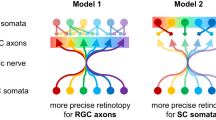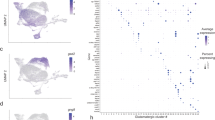Abstract
ARTHROPOD compound eyes consist typically of square or hexagonal facets beneath each of which lies a group of photoreceptor cells. Each photoreceptor or retinula cell gives rise to a microvillar fringe, called the rhabdomere, which consists of parallel tubules containing light-absorbing visual pigments. Axons arising from the retinula cells of each group are usually arranged in distinct bundles. These pass through the basement membrane and enter the first optic ganglion, the lamina, where they synapse with second-order neurones.
This is a preview of subscription content, access via your institution
Access options
Subscribe to this journal
Receive 51 print issues and online access
$199.00 per year
only $3.90 per issue
Buy this article
- Purchase on Springer Link
- Instant access to full article PDF
Prices may be subject to local taxes which are calculated during checkout
Similar content being viewed by others
References
Braitenberg, V., Expl Brain Res. 3, 271–298 (1967).
Kirschfeld, K., Expl Brain Res., 3, 248–270 (1967).
Eguchi, E., Waterman, T. H., and Akiyama, J., J. gen. Physiol., 62, 355–374 (1973).
Hafner, G. S., J. comp. Neurol., 152, 255–280 (1973).
Eguchi, E., and Waterman, T. H., Proc. int. Symp. Functional Org. Compound Eye, 105–124 (Pergamon, Oxford, 1966),
Meyer-Rochow, V. B., Cytobiology, 4, 241–249 (1971).
Shaw, S. R., Vision Res., 9, 999–1029 (1969).
Snyder, A. W., J. comp. Physiol., 83, 331–360 (1973).
Meyer-Rochow, V. B., J. Insect. Physiol., 20, 573–589 (1974).
Parker, G. H., Mitt. Stat. Zool. Napoli, 12, 1–75 (1895).
Hàmori, J., and Horridge, G. A., J. Cell Sci., 1, 249–256 (1966).
Horridge, G. A., Z. vergl. Physiol., 55, 207–224 (1967).
Muller, K. J., J. Physiol., Lond., 232, 573–595 (1973).
Kirschfeld, K., Z. Naturforsch., 27 b, 578–579 (1972).
Waterman, T. H., Science, 120, 927–932 (1954).
Eguchi, E., and Waterman, T. H., Z. Zellforsch., 137, 145–157 (1973).
Bäuerlein, R., Forma et functio, 1 285–331 (1969).
Waterman, T. H., Wiersma, C. A. G., and Bush, B. M. H., J. cell. comp. Physiol., 63, 135–155 (1964).
Author information
Authors and Affiliations
Rights and permissions
About this article
Cite this article
MEYER-ROCHOW, V. Axonal wiring and polarisation sensitivity in eye of the rock lobster. Nature 254, 522–523 (1975). https://doi.org/10.1038/254522a0
Received:
Revised:
Published:
Issue Date:
DOI: https://doi.org/10.1038/254522a0
This article is cited by
-
Types and arrangements of neurons in the crayfish optic lamina
Cell and Tissue Research (1977)
-
Polarised light-sensitive interneurones in a swimming crab
Nature (1976)
Comments
By submitting a comment you agree to abide by our Terms and Community Guidelines. If you find something abusive or that does not comply with our terms or guidelines please flag it as inappropriate.



